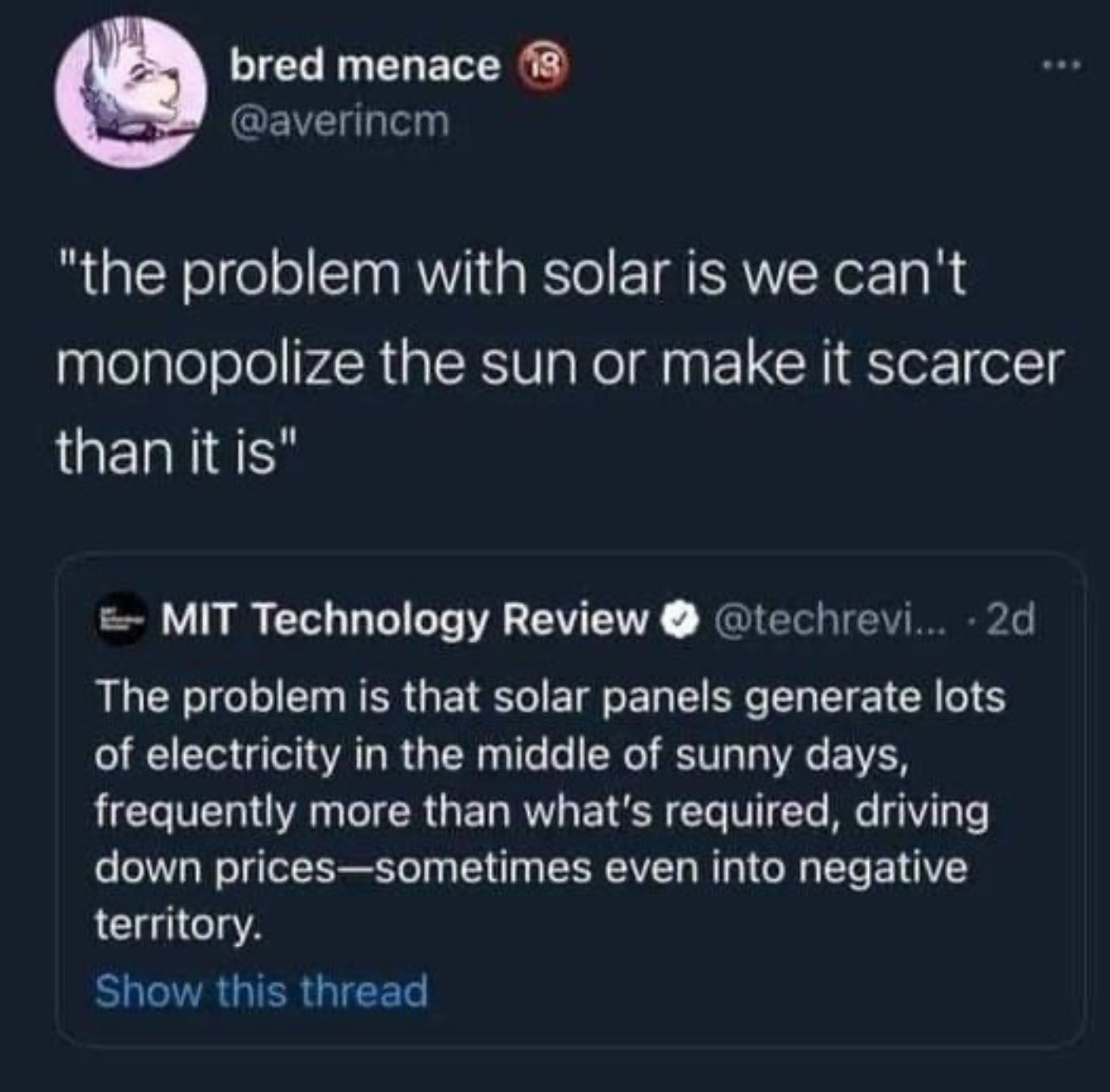this post was submitted on 02 Oct 2024
1686 points (95.6% liked)
Microblog Memes
6193 readers
2775 users here now
A place to share screenshots of Microblog posts, whether from Mastodon, tumblr, ~~Twitter~~ X, KBin, Threads or elsewhere.
Created as an evolution of White People Twitter and other tweet-capture subreddits.
Rules:
- Please put at least one word relevant to the post in the post title.
- Be nice.
- No advertising, brand promotion or guerilla marketing.
- Posters are encouraged to link to the toot or tweet etc in the description of posts.
Related communities:
founded 2 years ago
MODERATORS
you are viewing a single comment's thread
view the rest of the comments
view the rest of the comments

Piggybacking on your grid stability point, another issue I don’t see getting addressed here is ramp rate.
If we install enough solar where 100% of our daytime load is served by solar, that’s great. But what about when the solar starts to drop off later in the day?
A/Cs are still running while the sun is setting, the outside air is still hot. People are also getting home from work, and turning on their A/Cs to cool off the house, flipping on their lights, turning on the oven, etc.
Most grids have their peak power usage after solar has completely dropped off.
The issue then becomes: how can we serve that load? And you could say “just turn on some gas-fired units, at least most of the day was 100% renewable.”
But some gas units take literal hours to turn on. And if you’re 100% renewable during the day, you can’t have those gas units already online.
Grid operators have to leave their gas units online, running as low as they can, while the sun is out. So that when the peak hits, they can ramp up their grid to peak output, without any help from solar.
There are definitely some interesting solutions to this problem, energy storage, load shifting, and energy efficiency, but these are still in development.
People expect the lights to turn on when they flip the switch, and wouldn’t be very happy if that wasn’t the case. Grid operators are unable to provide that currently without dispatchable units.
Store the surprus of energy from the solar panels and use that as a buffer with batteries or gravity
Why not? Just time it and start it hours before, wind energy could help in that too
Gravity energy storage doesn’t scale well. I’ve replied to other comments with more detail on this.
There are more feasible energy storage technologies out there, but these are super cutting edge and are not ready for grid-level deployment yet.
The future of grid level energy storage is almost certainly not going to be gravity based. At least not on a large scale.
You can’t have 100% of load be renewable/solar and have gas units online on top of that. That’s over generation. You have to match the supply exactly with the demand. If you mismatch, you destabilize the grid. Undersupply causes blackouts, oversupply melts power lines.
If a unit takes 10 hours to start, solar hours are from 6am to 6pm, and peak load is at 7pm with 0% solar; when do you recommend we start this unit? At the minimum, we’d have to order it on at 7am. Units have to run at a minimum load, let’s say 100MW for this unit. So now you can’t 100% solar from 7am to 6pm, you have to leave 100MW of room for this base loaded unit.
This doesn’t even factor in regulatory requirements like flex, spinning reserve, and other balancing and reliability requirements. Grids are required to have emergency units available at an instant to prevent mass destabilization if parts of the grid fail.
10hours to start oof, i though it was less, maybe individual batteries in house, like we have with water?, that wouldn't be cheap for industry tho
To be fair 10 hours is either a pretty old or pretty massive unit. 2 hours might be a little more reflective of modern gas turbines. Especially combined cycles. But depending on how big the peak is, you need every available unit, both old and new.
Ultimately the issue is it’s very hard to meet that peak when all of your gas units have to go from 0 to 100% output. Much easier (and more reliable) to take them from 10% to 100%. Which is what grid operators do currently.
Yea an affordable battery in every home would be a slam dunk. This is kinda already happening with vehicle2grid (v2g) electric car protocols. But not everyone has an EV yet. And operators are still working out the kinks using this in the grid.
Plus the lithium batteries in cars have their own supply/recycling issues.
One solution to what you're describing is to expand the grid. If your grid stretches half the planet, when the East starts to experience night, the West still experiences day and can ship electricity from renewables to the East to make up for their self curtailment. The same goes for wind where if one location on the planet doesn't experience wind, odds are another location does and the power can be shuffled around.
Another option is to build out more battery storage such that any clipped energy from solar or wind - that is, the energy that can be generated from your solar or wind resource but that can't be exported because it would overload your inverters or transformers or exceed your PPA agreement with your utility - is stored and can be exported for 2-4 hours as the sun goes down or wind dies out.
Not a lot of renewables sites are colocated with battery storage, but more and more are.